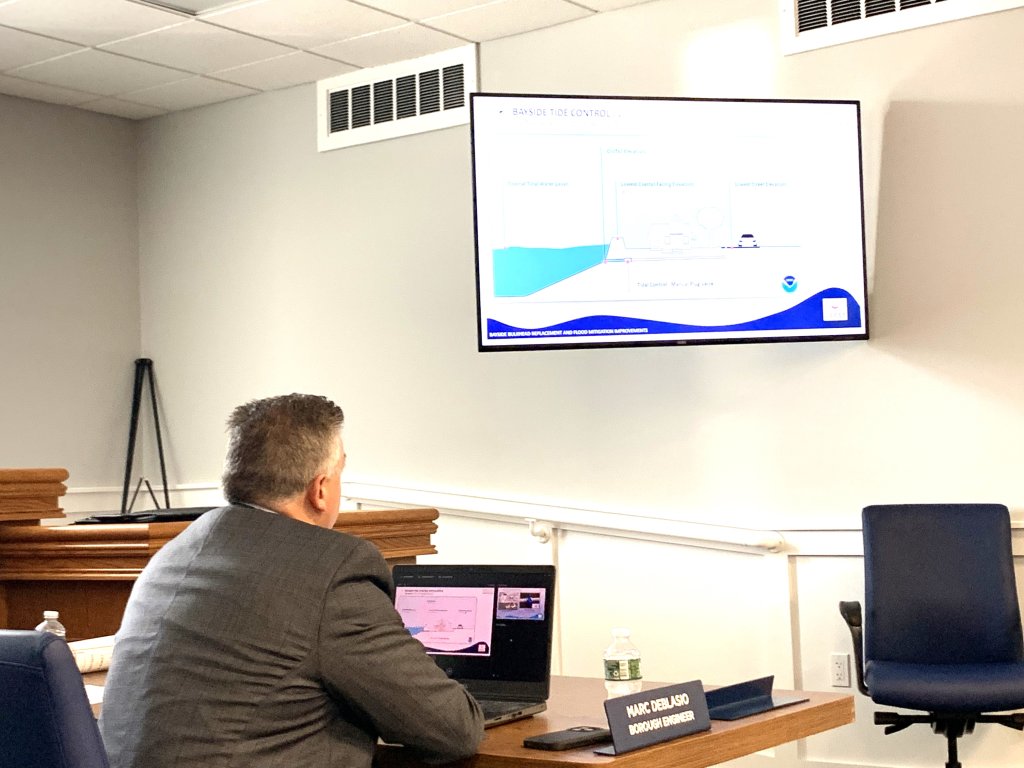WILDWOOD CREST – Residents got an update and raised questions about the borough’s $6 million Bayside Bulkhead Replacement and Flood Mitigation Improvement Project at the Board of Commissioners meeting May 22.
The project, scheduled to go out to bid this summer and be completed next summer, has three major components: Raising bulkheads to the 8-foot height mandated by the Federal Emergency Management Agency, installing new valves for stormwater outfall pipes on the bayside of the island and raising the road levels at the bayside street ends, said borough engineer Marc DeBlasio, who led the presentation.
Ten street ends between Primrose Road and Cardinal Road will get new bulkheads, storm drainage improvements, new valves and street-end raising. Another seven, from Aster Road to Cresse Avenue, will receive a new valve only. The new valves, DeBlasio said, will become part of the borough’s regular maintenance, and can be turned on or off following the tide schedules or as needed.
He said the project also includes the potential for two pumping stations.
The engineer showed a slide in his PowerPoint presentation that showed street-end flooding on Wisteria Road, which resident Colleen Brady called an “anomaly” that rarely happens there. DeBlasio said the image was taken in February.
In response to another resident’s question about the frequency of street-end flooding, he said there were probably 50 to 60 flooding events in the last 20 years, between two and three times per year. It has happened enough that residents of the back bay area, particularly along Lake Road, have been complaining about it and asking the borough to do something.
Brady asked why the borough was raising bulkheads, which she said would obstruct her view of the water. Mayor Don Cabrera said FEMA is requiring the borough to raise the bulkheads to 8.0 North American Vertical Datum of 1988, a standard for vertical surveying. The bulkhead at Wisteria Road is at elevation 4.92, so the bulkhead would be raised approximately 3 feet.
Other residents asked what good raised bulkheads at the street ends would do if the bulkheads on private property were not also raised. DeBlasio responded by saying the street-end improvements would reduce flooding by approximately 6 inches.
“The weakest link, so to speak, will be the private properties,” he said.
Cabrera said that when the borough approved a bulkhead ordinance it did not put a timeline in the ordinance requiring bayside private property owners to raise their bulkheads. Instead, the ordinance requires the bulkheads on private property to be raised only when there are property improvements equal to or greater than 50% of the value of the home.
At least one homeowner in the audience at the May 22 meeting said that requirement applied to him. DeBlasio said if he or anyone else faced that requirement, they should engage an engineer regarding tying into the new municipal bulkheads.
Another resident contended that despite the planned $6 million upgrade at the street ends, there would still be flooding if there were no dredging of the back bay area. DeBlasio said dredging would not change the situation.
He said water would find its own level and would continue to result in street-end flooding unless the borough’s actions were taken in cooperation with private properties.
Asked about how people are supposed to get to their docks if they are forced to raise bulkheads, DeBlasio said stairs might be a consideration.
He said the bulkhead replacement project was part of the borough’s flood mitigation and storm sewer master plan adopted in spring 2019.
Contact the reporter, Christopher South, at csouth@cmcherald.com or 609-886-8600, ext. 128.









